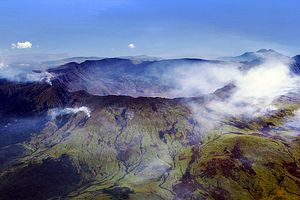Two hundred years ago, in 1815, the greatest volcanic eruption in recorded human history occurred. On April 10 and 11, 1815 Mount Tambora, a volcano located on the Indonesian island of Sumbawa, erupted. According to Smithsonian Magazine, Mount Tambora’s eruption was the largest such event of the last 10,000 years and produced some “thirty-six cubic miles of ash and rock and injected large amounts of small particles, or aerosols, into the stratosphere, which produced brilliantly colored skies on the other side of the world.”
The Economist reports that the explosion sent molten rock “more than 40 kilometers into the sky.”
The eruption was truly mighty:
The umbrella of ash spread out over a million square kilometres; in its shadow day was as night. Billions of tonnes of dust, gas, rock and ash scoured the mountain’s flanks in pyroclastic flows, hitting the surrounding sea hard enough to set off deadly tsunamis; the wave that hit eastern Java, 500 kilometers away, two hours later was still two metres high when it did so. The dying mountain’s roar was heard 2,000 kilometers away. Ships saw floating islands of pumice in the surrounding seas for years.
The number of lives lost due to the eruption is breathtaking. At least 10,000 individuals were killed directly from the volcano’s eruption and all vegetation on Sumbawa was destroyed. Later on, ash flows, tsunamis, and starvation led to the deaths of 60,000 to 120,000 more people, according to Clive Oppenheimer, a volcanologist at Cambridge University.
There was, however, an even broader, worldwide impact. The next year, 1816, is often known as the “Year Without a Summer.” Famines spread around the world, including in China’s Yunnan province and in Europe. In fact, the famines that occurred in Europe as a result of Mount Tambora’s explosion were the worst in the nineteenth century Europe. The New England region of the United States also faced extensive crop damage.
India faced multiple major famines during this period, as the monsoons were disrupted by the eruption’s aftermath. One of the strangest results of the explosion was the spread of cholera from India to the rest of the world. Cholera had previously been a mostly local disease in the Bengal region of the subcontinent, a swampy area in the Ganges river delta. Climatic changes and famine led to the emergence of a new strain of cholera, which was able to spread more easily. Around 1820, it moved out of Bengal and east into Myanmar and Thailand, before reaching Europe by 1831.
Today, one can see the ruins of the houses and civilization–the tiny Kingdom of Tambora–of the region of Sumbawa that was instantly buried by the erupting volcano. Often called the “Pompeii of the East,” the buried village, inhabited by 10,000 people, suggests a wealthy culture that was linked by trade with Cambodia and Vietnam. Ashes to ashes, dust to dust indeed.

































